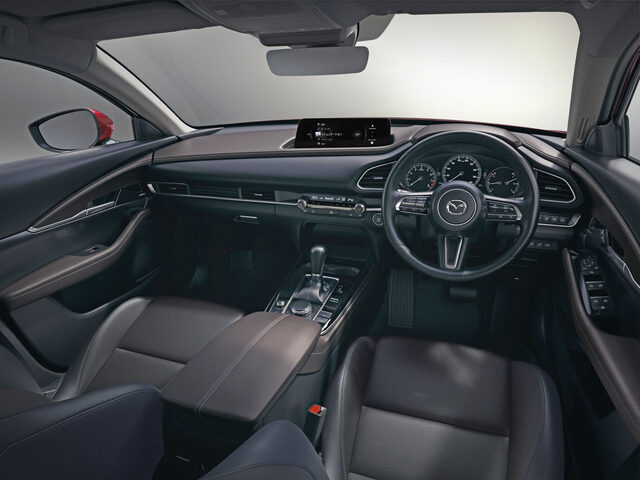Launched here in late 2020 the Mazda CX-30 is a small-medium SUV that squeezes into the space between the company’s original SUVs, the compact CX-3 and the mid-sized CX-5.
Between them, these three vehicles accounted for just over half of total Mazda sales in 2023 and were a major factor in the brand being locked solidly into second place behind Toyota in total sales.
CX-30 was given a minor upgrade in late 2023 that included improved connectivity and fuel efficiency, together with a new model grade, the GT SP.
The CX-30 now comes with five equipment levels, in ascending order: Pure, Evolve, Touring, GT SP and Astina.
Prices range from $33,290 for the Pure FWD through to $47,390 for an X25 Astina AWD. On-road costs need to be added.
STYLING
CX-30 has quite a conservative design which is likely to appeal more to owners at the older end of the age-scale. The shape is similar to the Mazda3 hatch but 100mm taller with 25mm extra ground clearance.
Although technically an SUV it has a sporty profile that’s almost coupe like.
At the front there are swooping headlamps flanking a large black version of the current Mazda family grille with an attractive textured fill. All variants get daytime running lights, LED in the Astina, halogen in the others.
The new GT SP gains a sleeker, more sporty appearance with exterior styling enhancements in the form of black alloy wheels, a black front grille and mirror caps finished in piano black.
The entry-level CX-30 Pure comes with 16-inch alloy wheels, all higher-grade models roll on 18s.
Out the back there are wraparound tail-lights, small roof spoiler, twin exhaust pipes and black plastic in the bumper.
Nine colours are available, five of them metallic are costed options.
INTERIOR
The quality of the cabin has taken the CX-30 to a new level. The driver benefits from a high seating position and auto dimming rear-view mirror. The leather-clad steering wheel offers a comfortable grip, plus paddle shifts and the air vents are angled to the driver, servicing the dual zone air-conditioning.
Versatile storage includes a good-sized centre console, and a space below the fascia thanks to the uptake of an electric parking brake, plus big door bins.
The dashboard isn’t as expansive as others in the segment but is well laid out and easy to read. We love the fact that it resisted the current trend of locating almost all controls in screens by the use of physical knobs for adjusting air conditioning and audio.
Pure and Evolve have manual black cloth seats. The others have two different grades of leather (black and burgundy) and 10-way power adjustment.
Versatile storage includes a good-sized centre console, and a space below the fascia thanks to the uptake of an electric parking brake, plus big door bins.
In the back, CX-30 has good headroom but legroom for taller passengers could be a problem. The smallish centre-rear seat is not unusual in this size class in that it’s hampered for footroom by the central tunnel.
There are air vents and a fold-down centre armrest with twin drink holders.
Boot space is 317 litres with the rear seatbacks folded. A space-saver wheel is stored under the boot floor.
ENGINES/TRANSMISSIONS
CX-30 offers either a Skyactiv-G 2.0-litre, or Skyactiv 2.5-litre petrol engine, mated with a six-speed Skyactiv automatic transmission, plus front-wheel or all-wheel drive.
The 2.0-litre Skyactive-G 2.0 generates 114 kW at 6000 rpm and 200 Nm at 4000 revs is available with all spec levels apart from the Touring SP.
Two variants, the Evolve G20e M and X20 Astina e-Skyactiv are mild hybrids and share the G 2.0 engine with a 24V lithium-ion battery.
The larger Skyactiv-G 2.5 engine has a 2.5-litre capacity with outputs of 139 kW at 6000 rpm and 252 Nm at 4000. It is available in the FWD or AWD Astina spec-level as well as Touring and Touring SP, AWD only.
The previous entry-level Pure came with a six-speed manual gearbox option but that was dropped with the latest upgrade and all models now have a six-speed torque converter automatic.
INFOTAINMENT
The top spec Astina and GT SP variants each get a 10.25-inch colour display. All below have an 8.8-inch centre screen. Note that neither is a touchscreen but rather the control system uses a rotary dial and accompanying buttons, situated on the centre console.
It’s large enough and within easy reach of the driver to minimise the amount of time taken away from looking at the road ahead.
Apple CarPlay and Android Auto are wired in the Pure and Evolve, wireless in all other models. Likewise, there are USB-A ports in Pure and Evolve and USB-C ports and wireless charging above.
Satellite navigation is standard across the CX-30 range.
SAFETY
Mazda has a long-standing and admirable focus on safety and this continues in the CX-30 which achieved one of the highest ANCAP crash scores to date, with 99 per cent in adult occupant protection.
All variants come with a comprehensive list of safety features including seven airbags (now with a driver’s knee bag), autonomous emergency braking in both forward and reverse, blind-spot monitoring, rear cross-traffic alert, adaptive cruise control with stop/go, lane-keep assist, traffic sign recognition, rear parking sensors, reversing camera, advanced speed assist system and IsoFix child seat anchorages.
The higher-spec models add a 360-degree view monitor, cruising and traffic support (traffic jam assist), front cross-traffic alert, driver monitoring and front parking sensors.
These latter features are available in other variants with an optional Vision Technology Pack.
DRIVING
Entry is relatively easy and the seats are supportive and comfortable. The steering wheel is height and reach adjustable and, even in the base level Pure, has leather wrapping as does the gear lever.
The 2.0-litre naturally aspirated petrol engine in our test Evolve lacks sharpness of the a turbocharger in the at 2.5 although the six-speed automatic worked well and had the SUV country cruising with confidence.
The new-generation Skyactiv Vehicle Architecture contributes towards excellent ride quality and interior sound levels. Coarse-chip surfaces do increase noise levels although not to the same extent as others in this class.
Handling is accurate and the steering wheel provides the right amount of feedback.
Cornering is accurate enough, but this is not a sports sedan, and is certainly not claiming to be one.
Fuel consumption on our test route sat in the nine to ten litres per hundred kilometres in suburban, motorway and rural segments. It dropped to just over the claimed 6.5 L/100km.
SUMMING UP
The CX-30 was the first Mazda model to adopt the two-digit suffix which was introduced to highlight the brand’s aim of pushing into the premium segment and competing against the big-name Europeans. It has subsequently been joined by the similarly-sized MX-30 together with CX-60, CX-70, CX-80 and CX-90 larger SUVs.
The CX-30 is a pleasant car to ride in and to drive. It’s built to Mazda’s usual high quality with a semi-premium feel, neat styling and, though not the cheapest in its class, offers good value for money.
It also achieved one of the highest ANCAP crash scores to date, achieving 99 per cent in adult occupant protection.
Like all new Mazda vehicles, the CX-30 comes with a five-year/unlimited kilometre warranty, as well as five years of Mazda Premium Roadside Assistance. Service intervals are every 10,000km or 12 months, whichever comes first.
RATINGS:
Looks: 7/10
Performance: 8/10
Safety: 9/10
Thirst: 8/10
Practicality: 8/10
Comfort: 7/10
Tech: 8/10
Value: 8/10









